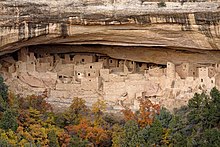
Back شعوب بويبلو القديمة Arabic Anasazi AST Старажытныя пуэбла Byelorussian Анасази Bulgarian Anasazi Catalan Anasaziové Czech Oprindelige Puebloere Danish Anasazi German Ανασάζι Greek Prapuebla kulturo Esperanto



The Ancestral Puebloans, also known as the Anasazi and by the earlier term the Basketmaker-Pueblo culture, were an ancient Native American culture that spanned the present-day Four Corners region of the United States, comprising southeastern Utah, northeastern Arizona, northwestern New Mexico, and southwestern Colorado.[1][2][3][4] They are believed to have developed, at least in part, from the Oshara tradition, which developed from the Picosa culture. The people and their archaeological culture are often referred to as Anasazi, a term introduced by Alfred V. Kidder from the Navajo word anaasází meaning 'enemy ancestors' (anaa– 'enemy', -sází 'their ancestors') although Kidder thought it meant 'old people'.[5][6] Contemporary Puebloans object to the use of this term, with some viewing it as derogatory.[7][8]
The Ancestral Puebloans lived in a range of structures that included small family pit houses, larger structures to house clans, grand pueblos, and cliff-sited dwellings for defense. They had a complex network linking hundreds of communities and population centers across the Colorado Plateau. They held a distinct knowledge of celestial sciences that found form in their architecture. The kiva, a congregational space that was used mostly for ceremonies, was an integral part of the community structure.
Archaeologists continue to debate when this distinct culture emerged. The current agreement, based on terminology defined by the Pecos Classification, suggests their emergence around the 12th century BCE, during the archaeologically designated Early Basketmaker II Era. Beginning with the earliest explorations and excavations, researchers identified Ancestral Puebloans as the forerunners of contemporary Pueblo peoples although specific site to modern group connections are unclear.[1][8] Three UNESCO World Heritage Sites located in the United States are credited to the Pueblos: Mesa Verde National Park, Chaco Culture National Historical Park and Taos Pueblo.
- ^ a b "Ancestral Pueblo culture". Encyclopædia Britannica. Retrieved 4 June 2012.
- ^ Woodbury, Richard B. (1979). "Prehistory: Introduction". In A. Ortiz (Ed.), Handbook of North American Indians: Southwest (Vol. 9, pp. 23). Washington, D.C.: Smithsonian Institution.
- ^ Plog, Fred. (1979). "Prehistory: Western Anasazi". In A. Ortiz (Ed.), Handbook of North American Indians: Southwest (Vol. 9, pp. 108–130). Washington, D.C.: Smithsonian Institution.
- ^ Cordell, Linda S. (1979). "Prehistory: Eastern Anasazi". In A. Ortiz (Ed.), Handbook of North American Indians: Southwest (Vol. 9, pp. 131–151). Washington, D.C.: Smithsonian Institution.
- ^ Plog, Fred. (1979). "Prehistory: Western Anasazi". In A. Ortiz (Ed.), Handbook of North American Indians: Southwest (Vol. 9, pp. 108). Washington, D.C.: Smithsonian Institution.
- ^ Kidder, Alfred V. (1936). Speculations on New World prehistory. In R.H. Lowie (Ed.), Essays in anthroplogy presented to Alfred L. Kroeber (p. 152). Berkeley: University of California Press.
- ^ Cordell, Linda; McBrinn, Maxine (2012). Archaeology of the Southwest (3 ed.).
- ^ a b Hewit (2010-07-09). "Puebloan Culture". University of Northern Colorado. Archived from the original on 2010-07-09.